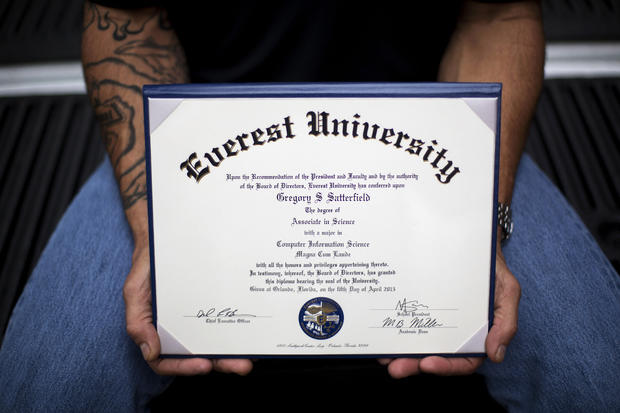4 ways to avoid for-profit college abuses
For more than a million students, nearly 4,000 for-profit or “career” colleges seemed to be a promising short-cut to a new job and higher pay.
Yet far too many graduates ended up not getting the job or salary of their dreams. Saddled with tens of thousands of dollars in college loans, for many, it’s been a nightmare. Clearly, there are better ways of improving vocational prospects without incurring a crippling financial burden.
“Far too many hard-working students are graduating with certificates or degrees that have little or no value in the job market, and then they’re stuck with thousands of dollars in student loans with no way to repay them,” outgoing Education Secretary John B. King Jr. told the Washington Post last Monday.
“When a student invests time and money to attend college, they need to be confident that it is a sound investment in their future, not a liability.”
With little accountability in recent years, the least-responsible for-profit companies knew the Department of Education’s massive federal loan program had their back. They all could get government loans for anyone who applied. Yet the colleges had little or no skin in the game.
Although it took years for the Department of Education to work through its cumbersome bureaucracy to come up with meaningful regulation, it knew about the for-profit problem decades ago – as far back as the Reagan Administration.
It wasn’t until the Obama Administration that the department first proposed “gainful employment” rules back in 2009.
At the time, it said that nearly half of all student loan dollars in default were from for-profit college students. The average student from these schools was carrying $14,000 in federal loan debt, a punishing burden considering these loans were mostly for two-year programs. More than 80% of for-profit students borrow to attend.
When officials at the department first talked about tougher rules for for-profit colleges six years ago, it’s possible they set the bar too low. Arne Duncan, the Education Secretary at the time, called for “at least 35 percent of former students repaying their loans” and loan repayments that didn’t exceed 30% of annual discretionary income. Colleges that didn’t meet these thresholds would be in danger of losing federal loan aid.
The failure of Corinthian Colleges, one of the largest for-profit chains, forced the government’s hand in 2015. It not only provided debt relief to Corinthian students, the department said it launched a broader crackdown on for-profit colleges and called upon Congress to tighten regulation.
While both the Education Department and Congress have been late to the game, in recent years the department collected data on how for-profit graduates fared relative to public college grads – something it should have done decades ago.
In a study published last year, it was discovered that for-profit college grads trailed public school grads to the tune of $9,000 a year in average annual earnings.
More importantly, for-profit grads lagged public grads badly in the “debt-to-earnings” ratio. That’s how much loan debt you have relative to your post-graduate salary: The higher the number, the worse off the graduate will be economically.
As a result of its modest enforcement, the government identified about 2,000 colleges that weren’t meeting its student debt guidelines, it reported last week. But colleges will only lose federal loan access if they fail to meet official benchmarks over four straight years, so the institutions have some wiggle room.
It’s too soon to tell whether the crackdown on for-profit colleges is helping a significant number of students avoid unnecessary debt. Education Undersecretary Ted Mitchell told the Washington Post last week that the number of “general education programs has dropped from 38,000 to 29,000 from 2014 to the present.” The department didn’t say whether the most abusive programs were among those that were cut.
For now, there are some simple ways to avoid heavy debt from for-profit colleges. Here are some key questions to ask:
· Have you considered local community colleges instead of a for-profit program? They are usually less expensive, offer hundreds of courses and provide more vocational support. Some of the best-funded colleges also offer non-loan aid. Many top students can attend for free in “honors” programs.
· Have you looked at the post-graduate earnings of each school? This is all public information, but the trend points to community colleges as having the edge, earning $2,700 more than for-profit grads, according to the Education Department.
· Have you looked at the average debt load of graduates? This is a critical number. If a for-profit school is graduating students with an average loan debt of $10,000 and a community college is half as much – or less – the decision should be clear cut.
· Does the college meet or exceed the Education Department’s “gainful employment standards” guidelines? If an institution is flagged by the government for underperforming, avoid it. It makes no sense to take on debt if you can’t pay it back when you’re working.
Of course, it’s hard to predict what will happen when the Trump Administration crafts its policies. Will the Education Department continue to crack down on for-profit abuses?
Considering that President-elect Trump agreed to a $25 million settlement last year to close out litigation connected with his for-profit Trump University, it’s hard to be optimistic that his administration will be diligent in reining in abusive career programs.
In the meantime, it’s up to you to find better, low- or no-debt alternatives that will lead to promising careers. A little homework is required, but no dissertation is involved.





